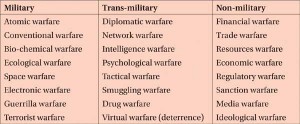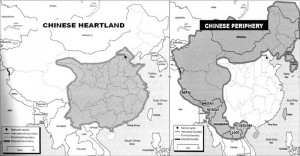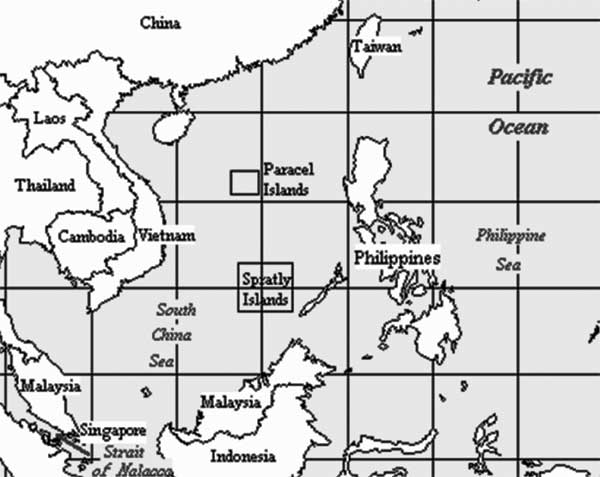For India, these are crucial times, and it should ensure ASEAN solidarity and a joint response to this imbroglio, a united front of South China Sea claimants (the Philippines, Vietnam, Indonesia, Malaysia, Brunei) negotiating jointly with China under the umbrella of ASEAN Regional Forum. Should all these islands be monitored by a Joint ARF Task Force, whose leadership can never be with China? Would a Joint Task Force of the ARF, under the leadership of the USA, be established to ensure implementation of UNCLOS in the South China Sea?
At this year’s Shangri-La Dialogue on Asian Security, China’s territorial claims in the South China Sea were in sharp focus…
Ever since the major step taken by Hu Jintao in 2006 to call 40 Heads of State of African nations and position China as an alternative source of economic assistance, China has systematically edged forward in various domains covertly and overtly, to challenge the existing World Order. As per Mercatior Institute of China Studies (Merics), China’s foreign policy is working systematically towards a realignment of the international order through establishing parallel structures to a wide range of international institutions.
China has taken on a key role in financing these alternative mechanisms that are designed to increase China’s autonomy vis-à-vis the US-dominated institutions and to expand its international sphere of influence. It currently follows a process of supplementing/complementing existing multi-lateral institutions. Thereafter, it would surely replace the existing order to suit its convenience. The “One Belt, One Road” initiative also appears to be part of this game plan, considering that China herself has burst the myth of its ‘Peaceful Rise’ – as evident in its extreme reactions to the verdict by the Permanent Court of Arbitration against its Nine-Dash Line and its stand-off with the Philippines.
At this year’s Shangri-La Dialogue on Asian Security, China’s territorial claims in the South China Sea were in sharp focus. Admiral Sun Jianguo again represented China at the conference, a position he is uniquely suited for due to his role as the Deputy Chief of the People’s Liberation Army General Staff with the foreign affairs portfolio. On this occasion, Admiral Sun left no room for negotiations on China’s stand on the South China Sea. He said, “I hope to again reiterate that China’s South China Sea Policy has not and cannot change.”
It is necessary to grasp the Chinese Grand-Strategy of Unrestricted Warfare to be able to gauge the inter-linking dimensions and stem this ‘Unpeaceful Rise’ of China…
In addition to ruling out a change in China’s basic position, Sun also hinted that China was seeking to replace or at least supersede regional security organisations, citing a speech by Xi Jinping on April 28, before the Conference on Interaction and Confidence-Building Measures in Asia (CICA), where the Chinese President and Communist Party General Secretary called for, “the building of a new architecture of regional security cooperation that reflects Asian needs” (Xinhua, April 28). Thus, in a step-by-step integrated approach, China seeks to become the sole arbiter for all issues confronting the world, whether in the economic, commerce, defence, diplomatic, political or social domains.
Analysts and policy makers look at each event independent of the other and are thus stymied by their responses, considering that China looks at each as a part of the whole. It benefits from the governance system it has wherein the General Secretary of the CCP controls all facets of the system and dictates the policies that facilitate each other. China seems to have grasped the nuance of Sun Tzu’s famous saying, “The acme of Generalship is to defeat the enemy before war is joined.” With its ‘Unrestricted Warfare’ concept as enunciated in 1999, China has been moving ahead relentlessly with the single-minded purpose of ensuring her rise as the sole super-power at the expense of USA.
China is using military, quasi-military and non-military domains unrelentingly to achieve this end. With a common goal and purpose overarching all the policies in these domains, each step forward in any domain strengthens the rest, akin to a ‘Force Multiplier’, thereby ensuring that the sum as a whole is more than the sum of the parts.
The South China Sea imbroglio is one such event, which is a part of the overall push by China to attain its goal. However, it needs to counter the ‘Revenge of Geography’ (to borrow the quote of Robert Kaplan), to enable it to provide adequate buffer to the Han heartland from its Eastern seaboard. It is, therefore, necessary to grasp the Chinese Grand-Strategy of Unrestricted Warfare to be able to gauge the inter-linking dimensions, and be able to stem this ‘Unpeaceful Rise’ of China. It needs to be a comprehensive strategy to enable the world to be able to withstand economic, political, diplomatic and military outcomes.
Military strategists of China have elaborated a “unified field theory” of war in which the kinetic dimension is no longer dominant…
Unrestricted Warfare: A People’s War in other Dimensions
“Fighting power is but one of the instruments of grand strategy – which should take account of and apply the power of financial pressure, of diplomatic pressure, of commercial pressure and not least of ethical pressure, to weaken the opponents’ will… Unlike strategy, the realm of grand strategy is for the most part terra incognita – still awaiting exploration, and understanding.” —B.H. Liddell Hart, Strategy (1954)
Military strategists of China have elaborated a “unified field theory” of war in which the kinetic dimension is no longer dominant. The most articulate example of such theory to date. remains the manifesto published in 1999 by Colonels Qiao Liang and Wang Xiangsui and translated in English under the somewhat misleading title of Unrestricted Warfare (Chao Xian Zhan, literally ‘War Beyond Rules’ or ‘Beyond-limits Combined War’).
Such a grand-strategy has eight principles, as under:
- Omni directionality – no distinction between what is or is not a battlefield.
- Synchrony – key factors in different space and domains brought to bear within the same designated time period (not necessarily precisely at the same time).
- Limited objectives – creeping forward, within limits based on capabilities at each step.
- Unlimited measures – enlarge scope, space and domains to attain the limited objectives: limited must be pursued in unlimited ways.
- Asymmetry – identify and exploit weak spots and calibrate asymmetrical response to develop any situation as per requirement.
- Minimal consumption – rational designation of objective(s) to make it a step-by-step approach, combine varied dimensional responses to accomplish objective with minimum consumption.
- Multi-dimensional coordination – ensure proper co-ordination between all space and domains of response to accomplish objective. Exploit intangible strategic resources such as ethnic identity, international rules/laws/organisations and socio-cultural/political divides .
- Adjustment and control of the entire process – need feedback and revision at every stage to calibrate resources, space and domains of response based on the enemy’s reactions and thereby ensure initiative is maintained.
Based on the above principles, there are 24 lines of operation identified in the Military, Trans-military, and Non-military domains as under:
 The implication is that China has moved on to a People’s War in all domains against all nations including the existing world powers, to ensure that it has an unhindered rise. Considering the shadow institutions it has setup and the desire to supersede the existing security organisations, it is clear that China sees itself as the sole superpower in the long term and is moving towards that goal in a step-by-step approach. What Admiral Sun left unsaid at the Shangri La Dialogue was that superseding the Regional Security Structures, was just the first step.
The implication is that China has moved on to a People’s War in all domains against all nations including the existing world powers, to ensure that it has an unhindered rise. Considering the shadow institutions it has setup and the desire to supersede the existing security organisations, it is clear that China sees itself as the sole superpower in the long term and is moving towards that goal in a step-by-step approach. What Admiral Sun left unsaid at the Shangri La Dialogue was that superseding the Regional Security Structures, was just the first step.
China needs to first secure its heartland from land, sea, space, cyber, economic, commercial, diplomatic, social and air threats…
In its march towards a ‘full spectrum’ domination of the world, China needs to first secure its heartland from land, sea, space, cyber, economic, commercial, diplomatic, social and air threats. The South China Sea dominance and subsequent dominance of the East China and Philippines Sea are steps in consonance with this unstated goal. Without the control of the open seas, as enunciated by Admiral Liu Huaqing, (the father of PLA Navy, in his ‘Offshore Defence’ Maritime Strategy in 1986), China would be militarily weak, as the maritime geography of the Eastern Seaboard leaves the ‘Chinese Heartland’ vulnerable to naval attacks.
Currently, the only threat that it faces from the land is from India; but that mainly targets the periphery and not the heartland. East Arunachal, Myanmar, North Vietnam and Laos are critical to China as these provide access to the fringes of its heartland. It appears that the only reason it is dragging the boundary resolution with India is this vulnerability on the Eastern Seaboard. It fears that the intervention by the US Navy, in case of a boundary war with India, would make it lose face with heavy strikes on the Han heartland. So the procrastination with India appears to be its game plan, till it secures itself along the Eastern Seaboard up to the Second Island Chain or till the West Philippine Sea at least.
 Towards that end, it started first with its ‘Economic Push’, to ensure that China gets firmly embedded in the world market and ASEAN, as the manufacturing hub, through the 1990s and the early 2000s. Most of the MNCs have their major factories on the Eastern Seaboard of China earmarked as SEZs. At the same time, China has ensured that beyond this, there was no access to this industry into any other part of China.
Towards that end, it started first with its ‘Economic Push’, to ensure that China gets firmly embedded in the world market and ASEAN, as the manufacturing hub, through the 1990s and the early 2000s. Most of the MNCs have their major factories on the Eastern Seaboard of China earmarked as SEZs. At the same time, China has ensured that beyond this, there was no access to this industry into any other part of China.
At the heart of the South China Sea dispute is the “Nine-Dash Line”, Beijing’s claim that encircles as much as 90 per cent of the contested waters…
This economic integration, it correctly opined, would enable it to push the envelope in other domains as the world powers would hesitate to adopt stringent actions fearing an economic backlash. The fall of the Asian Tigers in the late 1990s provided China with a golden opportunity, which it grabbed with both hands. It ensured that China became one of the largest trading partners with each member of the ASEAN and also provided economic support to the economically weaker countries, Laos and Cambodia. It thus worked towards breaking the cohesion of the ASEAN to ensure that future face-off in the South China Sea would ensure no coherent response. This was proved right, considering the muted response to China’s refusal to accept the PCA’s verdict.
Learning from the Tiananmen Square incident, the ‘Colour Revolutions’ in Russia’s periphery and the reach of the social media in its success, it has denied access to them by creating a parallel internet web and social media network in its language that it controls completely. Thus it has ensured the revival of the virtual ‘Bamboo Curtain’ of the Mao era.
Further, it has made inroads into the socio-political domain not only through its diaspora, but also by investing in the extant societal rifts in the various countries thereby weakening their fabric in a slow and steady manner and inhibit their Comprehensive National Power (CNP). In its classic asymmetric response to the various fleet exercises by the US with Japan, Australia, South Korea and India, China floods the area with hundreds of fishing boats and trawlers to impede the exercise. Obviously all are not civilian boats but any physical response could have other repercussions





